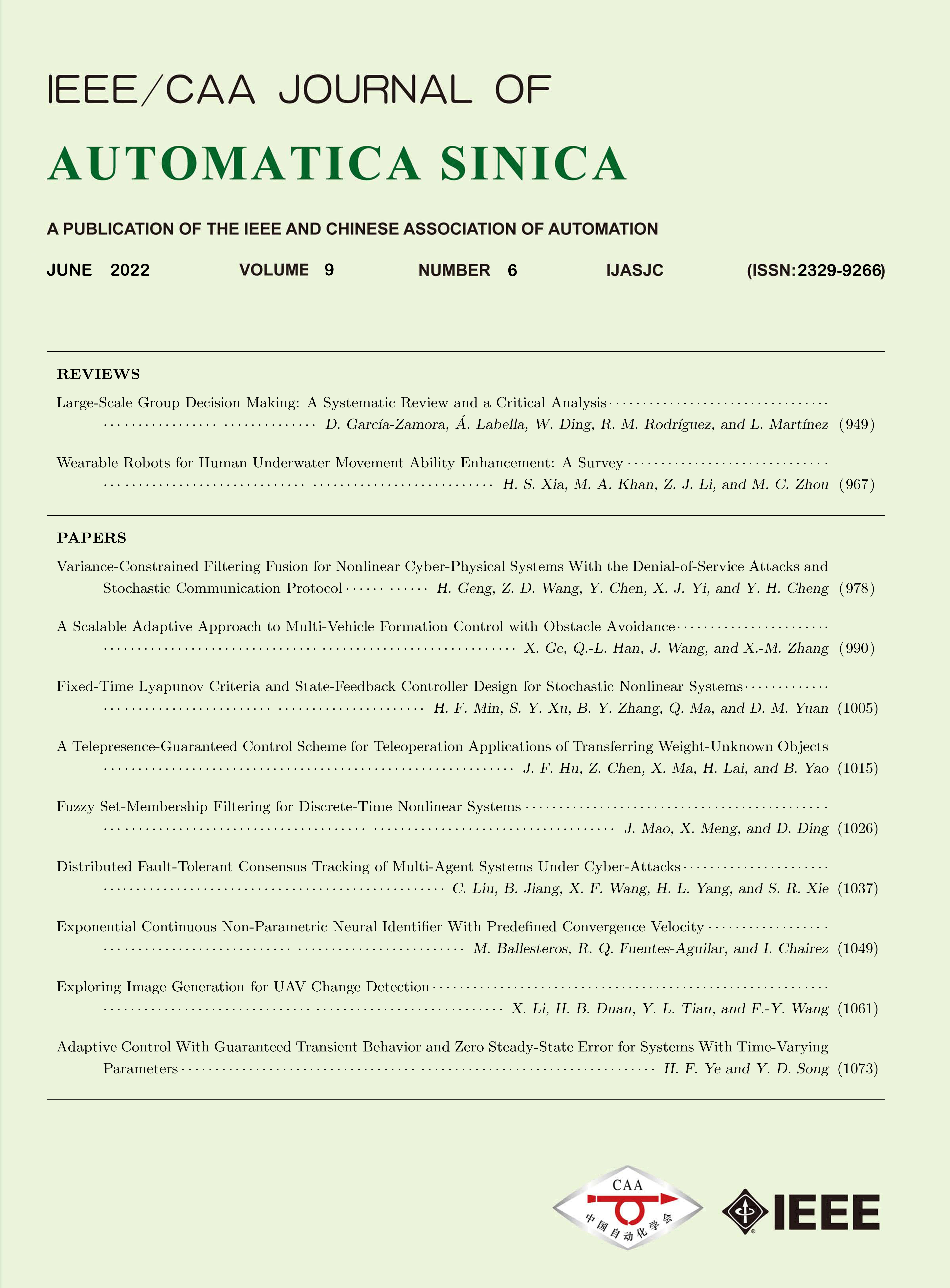 Volume 9
Issue 6
Volume 9
Issue 6
IEEE/CAA Journal of Automatica Sinica
| Citation: | J. Mao, X. Meng, and D. Ding, “Fuzzy set-membership filtering for discrete-time nonlinear systems,” IEEE/CAA J. Autom. Sinica, vol. 9, no. 6, pp. 1026–1036, Jun. 2022. doi: 10.1109/JAS.2022.105416 |

| [1] |
A. Ansari and D. S. Bernstein, “Input estimation for nonminimum-phase systems with application to acceleration estimation for a maneuvering vehicle,” IEEE Trans. Control Systems Technology, vol. 27, no. 4, pp. 1596–1607, 2019. doi: 10.1109/TCST.2018.2807798
|
| [2] |
T. Knudsen and J. Leth, “A new continuous discrete unscented Kalman filter,” IEEE Trans. Autom. Control, vol. 64, no. 5, pp. 2198–2205, 2019. doi: 10.1109/TAC.2018.2867325
|
| [3] |
R. Yildiz, M. Barut, and E. Zerdali, “A comprehensive comparison of extended and unscented Kalman filters for speed-sensorless control applications of induction motors,” IEEE Trans. Industrial Informatics, vol. 16, no. 10, pp. 6423–6432, 2020. doi: 10.1109/TII.2020.2964876
|
| [4] |
D. Ding, Q.-L. Han, Z. Wang, and X. Ge, “Recursive filtering of distributed cyber-physical systems with attack detection,” IEEE Trans. Systems,Man,and Cybernetics: Systems, pp. 1–11, 2020.
|
| [5] |
G. G. Koch, L. A. Maccari, R. C. L. F. Oliveira, and V. F. Montagner, “Robust
|
| [6] |
J. Zhao and L. Mili, “A decentralized
|
| [7] |
H. Gao, X. Meng, and T. Chen, “A parameter-dependent approach to robust
|
| [8] |
L. Zou, Z. Wang, Q.-L. Han, and D. Zhou, “Moving horizon estimation of networked nonlinear systems with random access protocol,” IEEE Trans. Systems,Man,and Cybernetics: Systems, vol. 51, no. 5, pp. 2937–2948, 2021. doi: 10.1109/TSMC.2019.2918002
|
| [9] |
Y. Zhao, X. He, J. Zhang, H. Ji, D. Zhou, and M. G. Pecht, “Detection of intermittent faults based on an optimally weighted moving average t2 control chart with stationary observations,” Automatica, vol. 123, Article No. 109298, 2021. doi: 10.1016/j.automatica.2020.109298
|
| [10] |
C. Peng and H. Sun, “Switching-like event-triggered control for networked control systems under malicious denial of service attacks,” IEEE Trans. Autom. Control, vol. 65, no. 9, pp. 3943–3949, 2020. doi: 10.1109/TAC.2020.2989773
|
| [11] |
F. Yang, N. Xia, and Q.-L. Han, “Event-based networked islanding detection for distributed solar PV generation systems,” IEEE Trans. Industrial Informatics, vol. 13, no. 1, pp. 322–329, 2017. doi: 10.1109/TII.2016.2607999
|
| [12] |
A. Benavoli and D. Piga, “A probabilistic interpretation of setmembership filtering: Application to polynomial systems through polytopic bounding,” Automatica, vol. 70, pp. 158–172, 2016. doi: 10.1016/j.automatica.2016.03.021
|
| [13] |
X. Ge, Q.-L. Han, and Z. Wang, “A dynamic event-triggered transmission scheme for distributed set-membership estimation over wireless sensor networks,” IEEE Trans. Cybernetics, vol. 49, no. 1, pp. 171–183, 2019. doi: 10.1109/TCYB.2017.2769722
|
| [14] |
L. Zou, Z. Wang, Q.-L. Han, and D. Zhou, “Full information estimation for time-varying systems subject to Round-Robin scheduling: A recursive filter approach,” IEEE Trans. Systems,Man,and Cybernetics: Systems, vol. 51, no. 3, pp. 1904–1916, 2021. doi: 10.1109/TSMC.2019.2907620
|
| [15] |
G. Calafiore, “Reliable localization using set-valued nonlinear filters,” IEEE Trans. Systems,Man,and Cybernetics - Part A: Systems and Humans, vol. 35, no. 2, pp. 189–197, 2005. doi: 10.1109/TSMCA.2005.843383
|
| [16] |
D. Merhy, C. Stoica Maniu, T. Alamo, E. F. Camacho, S. Ben Chabane, T. Chevet, M. Makarov, and I. Hinostroza, “Guaranteed set-membership state estimation of an octorotor’s position for radar applications,” Int. J. Control, vol. 93, no. 11, pp. 2760–2770, 2020. doi: 10.1080/00207179.2020.1825796
|
| [17] |
J. Dong and G.-H. Yang, “
|
| [18] |
Y. Liu, B.-Z. Guo, J. H. Park, and S. Lee, “Event-based reliable dissipative filtering for T–S fuzzy systems with asynchronous constraints,” IEEE Trans. Fuzzy Systems, vol. 26, no. 4, pp. 2089–2098, 2018. doi: 10.1109/TFUZZ.2017.2762633
|
| [19] |
F. Yang and Y. Li, “Set-membership fuzzy filtering for nonlinear discrete-time systems,” IEEE Trans. Systems,Man,and Cybernetics: Cybernetics, vol. 40, no. 1, pp. 116–124, 2010. doi: 10.1109/TSMCB.2009.2020436
|
| [20] |
S.-J. Huang, D.-Q. Zhang, L.-D. Guo, and L.-B. Wu, “Convergent estimation mechanism design for nonlinear fuzzy systems with faults,” IEEE Trans. Cybernetics, vol. 50, no. 5, pp. 2176–2185, 2020. doi: 10.1109/TCYB.2018.2884221
|
| [21] |
Y. Wang, H. R. Karimi, H.-K. Lam, and H. Yan, “Fuzzy output tracking control and filtering for nonlinear discrete-time descriptor systems under unreliable communication links,” IEEE Trans. Cybernetics, vol. 50, no. 6, pp. 2369–2379, 2020. doi: 10.1109/TCYB.2019.2920709
|
| [22] |
Y. Zhao, H. Gao, and J. Qiu, “Fuzzy observer based control for nonlinear coupled hyperbolic PDE-ODE systems,” IEEE Trans. Fuzzy Systems, vol. 27, no. 7, pp. 1332–1346, 2019. doi: 10.1109/TFUZZ.2018.2877635
|
| [23] |
H. Li, J. Wang, H. Du, and H. R. Karimi, “Adaptive sliding mode control for Takagi–Sugeno fuzzy systems and its applications,” IEEE Trans. Fuzzy Systems, vol. 26, no. 2, pp. 531–542, 2018. doi: 10.1109/TFUZZ.2017.2686357
|
| [24] |
D. P. Bertsekas, “Feature-based aggregation and deep reinforcement learning: A survey and some new implementations,” IEEE/CAA J. Autom. Sinica, vol. 6, no. 1, pp. 1–31, 2019. doi: 10.1109/JAS.2018.7511249
|
| [25] |
W. Chang, Y. Li, and S. Tong, “Adaptive fuzzy backstepping tracking control for flexible robotic manipulator,” IEEE/CAA J. Autom. Sinica, vol. 8, no. 12, pp. 1923–1930, 2021. doi: 10.1109/JAS.2017.7510886
|
| [26] |
W. Li, Z. Xie, Y. Cao, P. K. Wong, and J. Zhao, “Sampled-data asynchronous fuzzy output feedback control for active suspension systems in restricted frequency domain,” IEEE/CAA J. Autom. Sinica, vol. 8, no. 5, pp. 1052–1066, 2021. doi: 10.1109/JAS.2020.1003306
|
| [27] |
Y. Wang, V. Puig, and G. Cembrano, “Set-membership approach and Kalman observer based on zonotopes for discrete-time descriptor systems,” Automatica, vol. 93, pp. 435–443, 2018. doi: 10.1016/j.automatica.2018.03.082
|
| [28] |
A. Jiménez, B. M. Al-Hadithi, F. Matía, and R. Haber-Haber, “Improvement of Takagi-Sugeno fuzzy model for the estimation of nonlinear functions,” Asian J. Control, vol. 14, no. 2, pp. 320–334, 2012. doi: 10.1002/asjc.310
|
| [29] |
S. P. Boyd, Linear Matrix Inequalities in System and Control Theory. Philadelphia: Society for Industrial and Applied Mathematics, 1994.
|